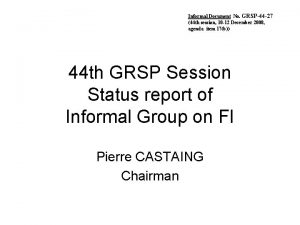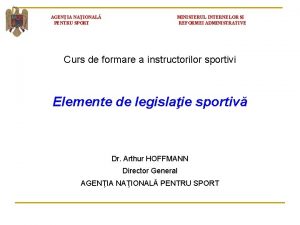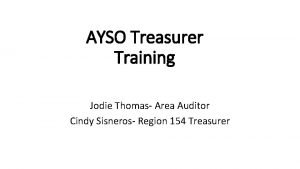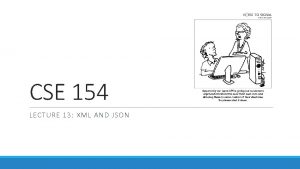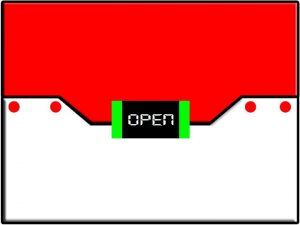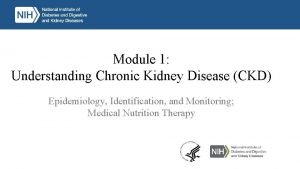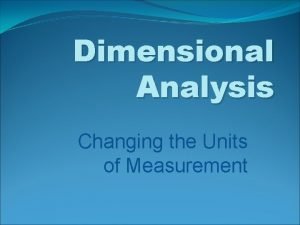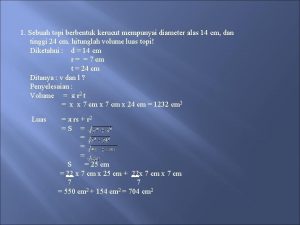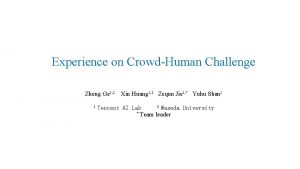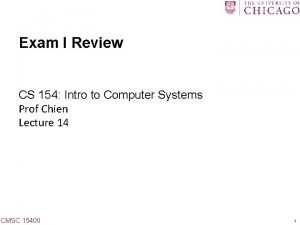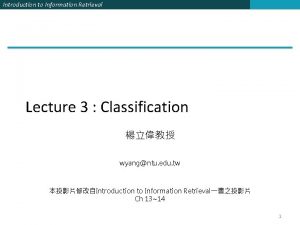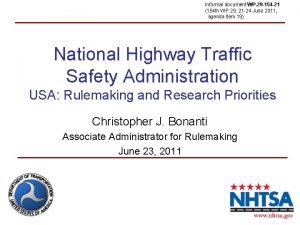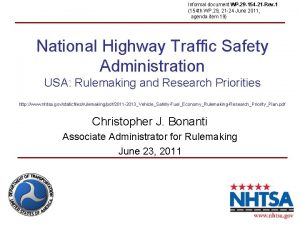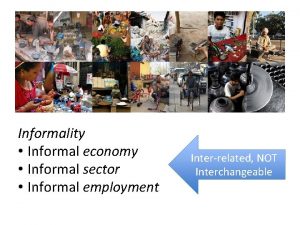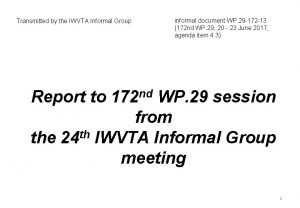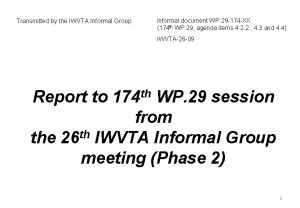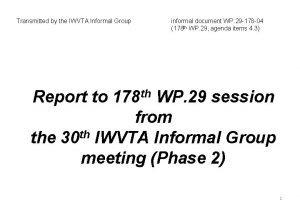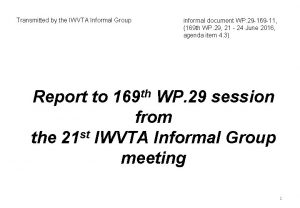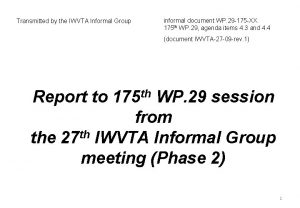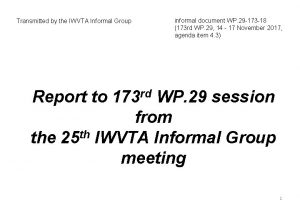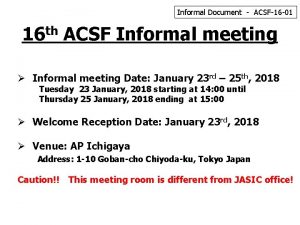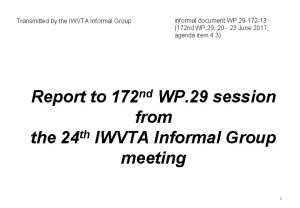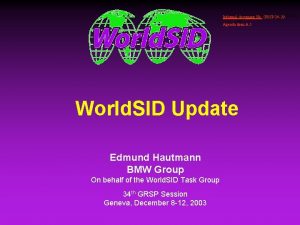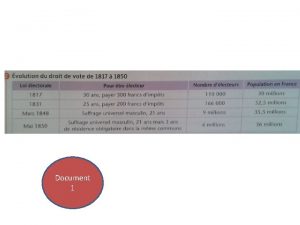Informal document No WP 29 154 10 154
























- Slides: 24

Informal document No. WP. 29 -154 -10 (154 th WP. 29, 21 -24 June 2011, Agenda item 19) New Priorities of Japan -Future Measures for Vehicle Safety for a Society with No Traffic Accidents 154 th Session of WP. 29 June 2011 1 Ministry of Land, Infrastructure, Transport and Tourism

CONTENTS 1. CURRENT STATUS 2. TARGET 3. CHANGING OF THE ENVIRONMENT SURROUNDING MOTOR VEHICLES 4. TASKS AHEAD (1) Respond to the Declining Birthrate and Aging Population (2) Prevent Involvements and Reduce Damage of Pedestrians and Cyclists (3) Respond to Needs for New Mobility (4) Prevent Serious Accidents Involving Large-Sized Vehicles 5. OTHERS 6. SETTING A NUMERICAL TARGET 2

Number of deaths within 30 days Number of injuries 896, 208 Number of deaths within 30 days 5, 745 Number of deaths 4, 863 Evolution of traffic accidents Number of accidents (in ten thousands) Number of injuries (in ten thousands) Number of vehicles in use (in millions) 1. CURRENT STATUS 3

2. TARGET Ø “We’ll reduce the number of deaths in traffic accidents to below 2, 500 by 2018 and make Japan a country of highest traffic safety in the world. “ (January 2010, the Minister of State for Special Mission) Ø “We’ll reduce the number of deaths within 24 hours to below 3 000 by 2015 aiming at eventually building a society with no traffic accidents. “ (March 2011, Ninth Fundamental Traffic Safety Program) 4 Traffic accident fatalities for 100, 000 of population

3. CHANGING OF THE ENVIRONMENT SURROUNDING MOTOR VEHICLES With the fastest aging population in the world and rapid spread of hybrid and electric vehicles, the environment surrounding the traffic community and motor vehicles is drastically changing. 14 000 50, 0% 10 000 35, 0% 8 000 30, 0% Total population 総人口(万人) 25, 0% (In ten thousands) 6 000 Rate of aging 高齢化率 4 000 75歳以上人口割合 older 20, 0% Rate of Age 75 or 15, 0% 10, 0% 2 000 5, 0% 50 20 40 20 30 20 20 20 10 20 00 20 90 19 80 19 70 19 60 0, 0% 19 50 0 19 Number of total population (In ten thousands) 40, 0% Rate of aging / age 75 or older 45, 0% 12 000 Evolution of declining birthrate and aging population and future estimate 5

Number of vehicles in use 3. CHANGING OF THE ENVIRONMENT SURROUNDING MOTOR VEHICLES 6

4. TASKS AHEAD Index (1) Respond to the Declining Birthrate and Aging Population Evolution of number of license holders according to age by sex (Index) 7

4. TASKS AHEAD Number of accident (1) Respond to the Declining Birthrate and Aging Population Evolution of the number of traffic accidents by age group (primary party, including moped drivers) 8

4. TASKS AHEAD (1) Respond to the Declining Birthrate and Aging Population Ø With the aging of the population, the number of elderly drivers and the number of traffic accidents caused by this age group has been increasing. u Develop and spread passenger protection technologies responsive to the needs of the elderly, etc. u Develop and spread driver assistance systems responsive to the needs of elderly drivers. 9

4. TASKS AHEAD (1) Respond to the Declining Birthrate and Aging Population Ø Child restraint systems are used by 60% of vehicles, but 60% of those are used incorrectly. (%) Child restraint systems( for baby / for infant) installation u Enhance activities among automobile users to raise their awareness of the necessity and importance of child restraint systems and let the secure and proper use of child restraint systems well known. 10

4. TASKS AHEAD (2) Prevent Involvements and Reduce Damage of Pedestrians and Cyclists Ø Pedestrians accounts for the majority of deaths. With cyclists, they represent the half of all deaths 11 Deaths and injuries by situation (2010)

4. TASKS AHEAD (2) Prevent Involvements and Reduce Damage of Pedestrians and Cyclists Ø The elderly age 65 or older and children of age 15 or younger find more deaths and injuries while walking or cycling than other age groups. 12 Ratio of deaths according to state and age

4. TASKS AHEAD (2) Prevent Involvements and Reduce Damage of Pedestrians and Cyclists Ø In pedestrian-vehicle accidents, the rate of death significantly increases after the hazard recognition speed exceeds 30 km/h. Composition rate Cumulative composition rate Composition rate in pedestrian-vehicle accident according to dangerous acknowledgment speed (2008) 13

4. TASKS AHEAD (2) Prevent Involvements and Reduce Damage of Pedestrians and Cyclists u Enhance pedestrian protection regulations for motor vehicles u Study the development and promotion of preventive safety technologies (Advanced emergency braking system(AEBS), intelligent speed adaptation (ISA), etc. ) to prevent accidents and sufficiently reduce collision speed. 14

4. TASKS AHEAD (3) Respond to Needs for New Mobility Ø With increasing environmental awareness, hybrid and electric vehicles are rapidly spreading. Lithium ion storage battery for automobile Workshop concerning quietness of hybrid vehicles u We need to establish technical regulations on lithium-ion batteries and quietness of these vehicles while running. 15

4. TASKS AHEAD (3) Respond to Needs for New Mobility ØThere is increasing interest in ultra-micro mobility as response to various needs such as increasing environmental awareness and mobility for the elderly. 16

4. TASKS AHEAD (3) Respond to Needs for New Mobility u Two-seater ultra-micro mobilities cannot be provided with the same level of collision safety as other vehicles. If they run in the same manner as other vehicles in the general traffic environment and meet accidents, passengers may get severely damaged. u However, we think that these ultra-micro mobilities offer features, advantages, and use of their own, just as motorcycles and currently used micro cars (of 50 cc or less) do. We find it appropriate to establish safety standards suited to the size and use of these vehicles; specifically, to study and develop standards on safety and driving performance, such as stability, based on the existing standards for micro cars. u Based on the above, we need to check the impact of their running public roads by 17 demonstration experiments and study desirable fields of use, desired performance, etc.

4. TASKS AHEAD (3) Respond to Needs for New Mobility u As for mobility assistance robots, firstly we need to check its acceptance by traffic community. We will keep studying this question based on the results of the demonstration experiments to be conducted in experimental zones starting 2011. 18

4. TASKS AHEAD (4)Prevent Serious Accidents Involving Large-Sized Vehicles Ø Accidents involving large-sized vehicles are not many, but, once caused, they entail heavy damage. High rate of death, heavy damage once caused 19 Death rates by type of vehicle involved (Primary party) in 2010

4. TASKS AHEAD (4)Prevent Serious Accidents Involving Large-Sized Vehicles u. Enhance support for or make mandatory the introduction of preventive safety technologies (AEBS, wobble-driving warning system, lane departure warning system (LDWS), etc. ) into commercial vehicles. u. As to diseases that might suddenly strike and disable the driver from keeping driving, study technologies that bring the vehicles to a stop safely even if the driver has been attacked by such a disease, especially for vehicles carrying many passengers such as buses, and heavy-duty trucks and cranes, 20 etc.

5. OTHERS (1) Enhance Accident Studies Ø To develop and spread preventive safety technologies and implement measures for the elderly, it is essential to study traffic accidents more in detail and clarify mechanisms of injury upon accident, driving and walking behaviors of the elderly, etc. u Develop a system of collection and analysis of data that enables us to make the best use of drive recorders and event data recorders (EDR) providing detailed information on accident. u In coordination with medical institutions, collect data on injury in accidents and emergency medical care. u Share data among parties concerned and develop detailed vehicle safety measures based on the 21 results of analysis of such data.

5. OTHERS (2)Study How a Driver Assistance System Should be Ø Preventive safety technologies are effective in reducing damage from traffic accidents, but drivers may depend too much on these technologies and fail to check safety themselves or go beyond the limits of their ability while driving. u Hold comprehensive discussion and sort out opinions on the level of technical regulations, findings on drivers’ situations, design of driver assistance systems, etc. , including legal issues. u Make aggressive efforts to let the functions and use of preventive safety technologies well known to automobile users. 22

6. SETTING A NUMERICAL TARGET Ø Based on the governmental target for 2018, we have set a target of reducing the number of victims by about one third measures. Reduce the number of traffic deaths (within 30 days) by 1, 000 by 2020 (from the 2010 level) 23

Thank you for your attention 24 Ministry of Land, Infrastructure, Transport and Tourism
 자바스크립트 쿠키
자바스크립트 쿠키 Informal document
Informal document Ordinul 154 din 2004
Ordinul 154 din 2004 Duties of treasurer
Duties of treasurer Cse 154
Cse 154 Cs 154 stanford
Cs 154 stanford Dodo akan memberi kado ulang tahun buat desi
Dodo akan memberi kado ulang tahun buat desi Nkdep
Nkdep A person's weight is 154 pounds convert this to kilograms
A person's weight is 154 pounds convert this to kilograms Cs 154 sjsu
Cs 154 sjsu Sebuah bandul berbentuk kerucut
Sebuah bandul berbentuk kerucut Senet-154
Senet-154 Uchicago cs 154
Uchicago cs 154 Lunar landing mission
Lunar landing mission Inst154
Inst154 Al baqarah 154-157
Al baqarah 154-157 Equal protection for english language learners
Equal protection for english language learners Cse 154
Cse 154 Homework 154
Homework 154 Que es el lenguaje culto formal
Que es el lenguaje culto formal Bvf document
Bvf document Contoh kebijakan keamanan informasi
Contoh kebijakan keamanan informasi Porter féle értéklánc
Porter féle értéklánc How many years did a spartan boy spend in the agoge
How many years did a spartan boy spend in the agoge Document a dbq answers
Document a dbq answers

